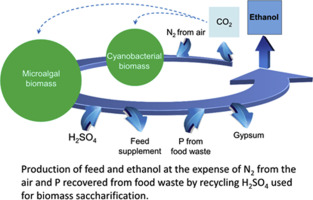Journal of Cleaner Production, Volume 219, 10 May 2019, Pages 217-224, 2019
Highlights
- A multitrophic semi-closed loop biomass production platform is proposed.
- N and P fertilizers were produced on site from air and bone meal, respectively.
- Ethanol was produced at 0.25 g. g microlgal biomass−1 along with animal feed.
- Sulfuric acid integrated biomass saccharification and efficient P recovery.
- Nutrients in vinasse and water were recycled to close the production cycle.
Abstract
Production of microalgal biomass for feed and fuels demands unsustainable large amounts of fertilizers. The most broadly considered alternative sources of nutrients/fertilizer for microalgae are wastewater and internal recycling in closed-loop production platforms. However, these strategies largely disable co-production of feed and fuel in biomass biorefineries for an increased economic and environmental feasibility.
In this study, we aimed at providing proof-of-concept for a semi-closed loop microalgal production-platform and biomass biorefinery for ethanol and feed from renewable resources of N and P. Atmospheric N2 was assimilated into a N2-fixing cyanobacterial biomass, which sustained growth of a microalga that accumulated high levels of carbohydrates (up to 60% (w/w)) as a sole source of fertilizer. The microalgal biomass was efficiently saccharified with H2SO4, which was recycled to release soluble PO43- from bone meal as a renewable source of P. Fermenting these P-enriched preparations with yeasts quantitatively produced ethanol at theoretical yields, a concentration of up to 50 g ethanol. L−1 and a yield of 0.25 g ethanol. g biomass−1. Calculations suggested a potential yield from 7600 to 10,800 L ethanol. ha−1. year−1, under Buenos Aires environmental conditions, which would be higher than that currently obtained from maize feedstocks. The residual fermentation vinasse, supplemented with P and containing other downstream-process reagents, was recycled as a sole source of macronutrients for the cultivation of the N2-fixing cyanobacterium to close the production cycle. Water recycling and co-production of residual biomass enriched in fat and protein as potential feed are also shown. This semi-closed loop biomass production-platform reconciles the concepts of microalgal biomass biorefineries for the co-production of feedstocks for biofuels and feed and nutrients recycling in closed-loop systems that largely minimizes production of waste.
Keywords
Ethanol, Feed, Biological N2-fixation,Bone meal, Sulfuric acid
Graphical abstract
